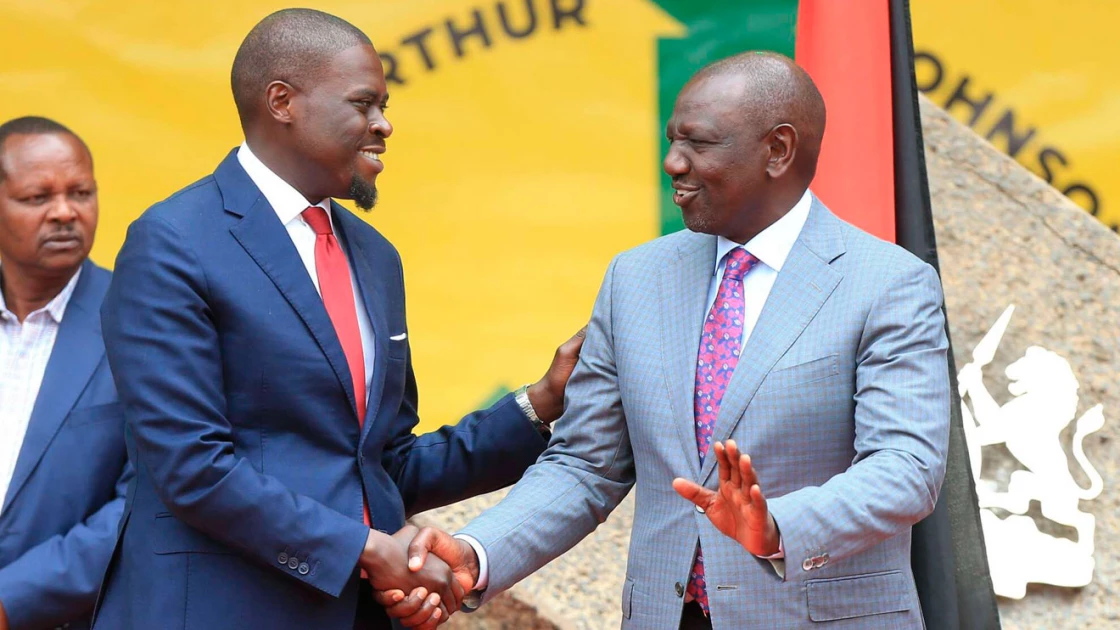Ruto's new attempt to restore Nairobi through deal with Sakaja


Audio By Vocalize
Nairobi, fondly referred to as “The Green City in the Sun", is governed by collective ownership, where citizens are happy and well-provided for through collective effort and good governance. Nairobi’s nickname is not an official designation but rather a colloquial expression that captures the essence of the city's atmosphere and appeal. It has a sunny climate characterised by warm temperatures and abundant sunshine throughout the year.
Its slogan mirrors its geographical location near the equator, which generally has mild and pleasant weather. Additionally, the slogan symbolizes its vibrant energy and dynamic growth as a major urban center in East and Central Africa.
But all this seems to be behind now as the city is literally under siege, from hawkers jostling every space in the city streets, to garbage choking the trenches and sidewalks; Nairobi has become a gangsters’ paradise as knife and poop-wielding thugs lurk around public spaces within the Central Business District (CBD) in broad daylight.
Paved city roads are in gross disrepair and a number of them are impassable. Image-conscious organizations and businesses have left the CBD in their droves for better locations. A long raft of failures has made the CBD an eyesore.
Who gets a piece of Nairobi?
Over the past three years, it has been a matter of “when,” not “if,” the national government would crack the whip. And so it came as no surprise when President William Ruto announced that plans were underway to restore Nairobi City’s image through better waste management, motorable roads, and working street lights, among other services.
This development triggers memories of Mike Sonko, the first Governor of Nairobi to be impeached. On February 25, 2020, the then-Governor of Nairobi was summoned to State House to sign away certain core functions of his administration to a new National Government entity called the Nairobi Metropolitan Services (NMS).
Effective service delivery suffered then, as now, as politics and sideshows took center stage. Nairobi was choking under filth, Nairobi’s most reliable drainage system was evaporation, and traffic jams were as desirable as scientific experiments. Not to mention the proliferation of street families was a non-issue as if they too served as a tourist attraction.
The City of Nairobi is the melting pot of politics in Kenya. The Capital City of Nairobi is not only the Administrative Capital of Kenya but also the Commercial Capital of the country.
Nairobi's economy generates about 27.4% to 27.5% of the country's Gross Domestic Product (GDP) and it is the largest contributor to the national economy, driving key sectors like manufacturing, information technology (IT), construction, services, and finance.
The governor of Nairobi, whoever it is, is a heartbeat from the top seat of the nation, the Presidency. This makes politics within Nairobi ‘high-octane’ as it attracts the attention and reaction of the occupant of the house on the hill, State House.
Looking back into history, the deeds and misdeeds of past governors of Nairobi could not pass unnoticed; the close proximity of the city to the seat of the nation made their tenures a lesson in walking on thorny grounds.
Kenyatta attempts to run Nairobi
Evans Kidero, who served from 2013 to 2017, had a frosty relationship with then-President Uhuru Kenyatta, most probably influenced by their political differences. President Kenyatta was the Jubilee party boss while Governor Evans Kidero was an ODM party adherent.
Shadow boxing and overt criticism across the divide ensured minimal progress within the city. The national government gave the county a wide berth, and on several occasions, suggestions and attempts by the Kenyatta administration to take back the county of Nairobi under the ambit of the national government were futile.
In 2017, Mike Sonko sent Evans Kidero packing during the second term of the Uhuru Administration. It did not take long before it became apparent to then-President, Uhuru Kenyatta, that the Nairobi City County administration was fighting too many legal and political wars to deliver on its mandate, but beyond that, the perceived incompetence of the governor to competently run the capital city was rife.
In a move that Sonko later termed as ‘arm-twisting,’ Kenyatta engineered a takeover of the county that occasioned the dramatic transfer of four key functions to the national government and, eventually, his impeachment. A specially created vehicle for the purpose of running the City County was created.
Sakaja’s tough balance
Under Johnson Sakaja, the third governor of Nairobi, the fights between him and the County Assembly have erupted over a number of issues, such as budget shares, development funding, and other programs, mainly the bursary funds.
A few months back, as the Nairobi MCAs sharpened their knives to cut off Sakaja via impeachment, it took the intervention of principals of the broad-based government, the late Raila Odinga and President Ruto to save him.
President Ruto’s declaration that “Nairobi cannot continue to be the city in filth,” was very telling, and many observers say that it was the clearest indication yet that he was no longer at ease with elected leaders of the Capital City’s administration. This was the ultimate signal that the time for change in Nairobi was nigh, without necessarily rocking the city with an impeachment.
Kenyatta’s administration seemed to have set a precedent that the current administration would only be too ready to follow.
Then, Devolution Cabinet Secretary Eugene Wamalwa signed the deed on behalf of the National Government while Sonko represented the Nairobi County Government. NMS was established on March 18, 2020, and Major General Mohammed Badi was appointed its Director-General.
The tenure of the deed was 24 months, ending in March 2022, with less than six months to the general elections. The NMS went on to do a stellar job even though the politics of the day bogged them down. The opposition was always too eager to paint the Uhuru Administration as militarizing the country’s secular positions by appointing serving military personnel to hitherto secular roles in the public service.
The Sakaja-era deal to co-manage the city is nigh. This deal is definitely not Sakaja’s chosen path; it would be an admission of failure. Rather, he has seemingly been nudged into it by President Ruto. His option out of it is low if not non-existent; his only ticket to remain relevant would be to fight to keep a few powerful dockets within his administration under the sole administration of the country government.
With the President's declaration on a deal to jointly manage the city with Sakaja’s administration, many observers say it is generally a euphemism for “step aside and see how this is done.” To add to this announcement, the president declared that a clean-up of the city was already underway, engaging thousands of young people already working on the Nairobi River Regeneration Project. The President also promised that all roads in the capital will be re-tarmacked.
Nairobi Deed of Transfer
The last time a decimation of the City County Government took place with Sonko in charge, the Kenya Gazette put it that the Nairobi City County Government was constrained internally to effectively discharge if functions. It also stated that some functions vested within the NCC would be more effectively performed and exercised by the National Government.
It said the NCC was desirous, just like today under Sakaja, of transferring to the National Government the functions set out in the Deed of Transfer of Functions and that the National Government had also accepted to undertake the responsibility as it had the requisite capacity and competence to perform the transferred functions.
The Deed of Transfer of Functions declared that the two parties solemnly agreed to effect the transfer of functions to the National Government. These were the County Health Services; the County Transport Services; the County Planning and Development Services; and the County Public Works, Utilities and Ancillary Services.
In May 2020, erstwhile allies of then-Deputy President Ruto roundly criticized Kenyatta for ‘militarizing’ state agencies. In a frosty spat, the current Interior Ministry Cabinet Secretary Kipchumba Murkomen, and back then the leader of Majority in Senate posed, “I would never have imagined that we passed the Constitution 2010. It is a shock that active military men who are supposed to operate in barracks and the borders of Kenya are running civilian governments.”
Murkomen censured Kenyatta’s decision to post military men to civilian entities as the worst form of violation and overturn of the Constitution.
With this admission that the Nairobi City County cannot deliver on its mandate and thus needs the help of the National Government. Has Sakaja failed? The details of the proposed joint capital city management are yet to be fleshed out, but, as usual, the devil will be lurking in the details.
To go the military way, after having criticized the militarized NMS during the Uhuru era, would be anathema, but the national government, in mentioning a collaboration with the private sector, might take the resultant partnership into the hands of private sector experts who might want to bring private sector efficiency and goal orientation into the picture. But whatever other amorphous entity it might be, good luck.

Leave a Comment